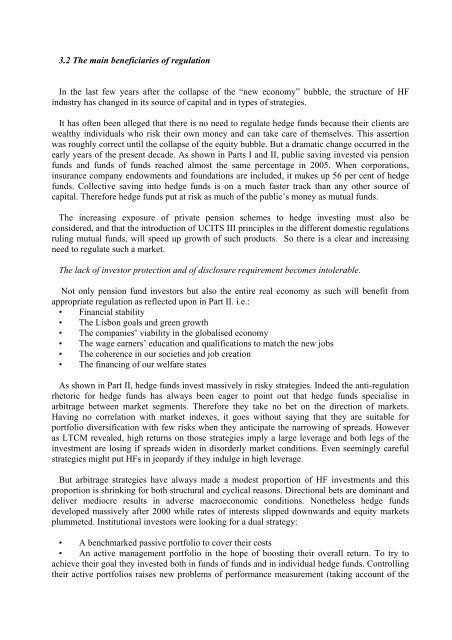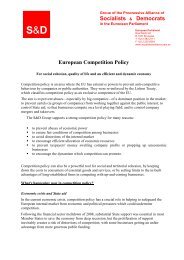Executive summary - Udo Bullmann
Executive summary - Udo Bullmann
Executive summary - Udo Bullmann
- No tags were found...
Create successful ePaper yourself
Turn your PDF publications into a flip-book with our unique Google optimized e-Paper software.
3.2 The main beneficiaries of regulationIn the last few years after the collapse of the “new economy” bubble, the structure of HFindustry has changed in its source of capital and in types of strategies.It has often been alleged that there is no need to regulate hedge funds because their clients arewealthy individuals who risk their own money and can take care of themselves. This assertionwas roughly correct until the collapse of the equity bubble. But a dramatic change occurred in theearly years of the present decade. As shown in Parts I and II, public saving invested via pensionfunds and funds of funds reached almost the same percentage in 2005. When corporations,insurance company endowments and foundations are included, it makes up 56 per cent of hedgefunds. Collective saving into hedge funds is on a much faster track than any other source ofcapital. Therefore hedge funds put at risk as much of the public’s money as mutual funds.The increasing exposure of private pension schemes to hedge investing must also beconsidered, and that the introduction of UCITS III principles in the different domestic regulationsruling mutual funds, will speed up growth of such products. So there is a clear and increasingneed to regulate such a market.The lack of investor protection and of disclosure requirement becomes intolerable.Not only pension fund investors but also the entire real economy as such will benefit fromappropriate regulation as reflected upon in Part II. i.e.:• Financial stability• The Lisbon goals and green growth• The companies’ viability in the globalised economy• The wage earners’ education and qualifications to match the new jobs• The coherence in our societies and job creation• The financing of our welfare statesAs shown in Part II, hedge funds invest massively in risky strategies. Indeed the anti-regulationrhetoric for hedge funds has always been eager to point out that hedge funds specialise inarbitrage between market segments. Therefore they take no bet on the direction of markets.Having no correlation with market indexes, it goes without saying that they are suitable forportfolio diversification with few risks when they anticipate the narrowing of spreads. Howeveras LTCM revealed, high returns on those strategies imply a large leverage and both legs of theinvestment are losing if spreads widen in disorderly market conditions. Even seemingly carefulstrategies might put HFs in jeopardy if they indulge in high leverage.But arbitrage strategies have always made a modest proportion of HF investments and thisproportion is shrinking for both structural and cyclical reasons. Directional bets are dominant anddeliver mediocre results in adverse macroeconomic conditions. Nonetheless hedge fundsdeveloped massively after 2000 while rates of interests slipped downwards and equity marketsplummeted. Institutional investors were looking for a dual strategy:• A benchmarked passive portfolio to cover their costs• An active management portfolio in the hope of boosting their overall return. To try toachieve their goal they invested both in funds of funds and in individual hedge funds. Controllingtheir active portfolios raises new problems of performance measurement (taking account of the





